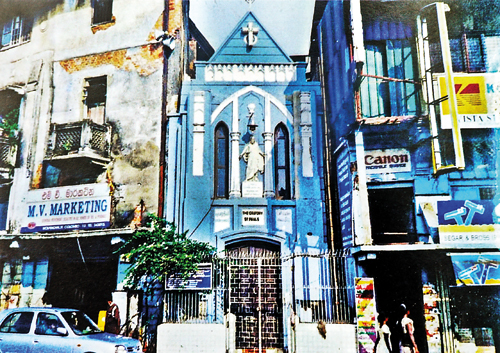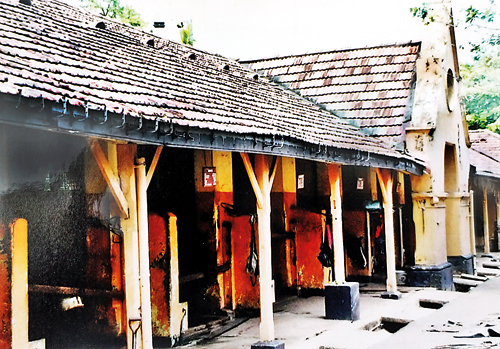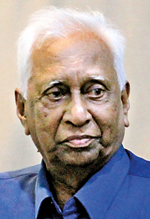Digging up a Royal ethos and tradition

Where it all began: Rev. J. Marsh started his Hill Street Academy in Wolfendhal 1835 where now stands the tiny chapel-Oratory of St. Paul’s built in 1932
“Beneath the sway of Marsh and Boake
Thenceforth did Lanka’s learning thrive.”
So sing the boys of Royal College. Yet how many can- at will- reach back over the long decades and conjure a cameo- at least- of those men who laid the foundation of a school that has a tradition as solid as any English public school?
These two men- like Hartley and Harward and Todd and Cull (and many others) have ossified into monochrome portraits looking down sternly on giggling boys and irreverent youths in the school hall.
The greatest service that will be done by D. L. Seneviratne’s elegant volume in blue and gold- titled From Marsh to Boake: The Founding Fathers of Royal College- would perhaps be to bring these two colossuses from the scene of the school’s birth pangs to startling and vivid life.
The author is a legend on the tennis turf. A management consultant and an industrial engineer, he was the President of the Sri Lanka Tennis Association for six years. His years at Royal (from 1948 to 1956) inspired him to undertake the amateur sleuthing that the book required.

From students to horses: These stables of the Police Mounted Division were once classrooms at the Colombo Academy
Royal’s first headmaster the Rev. Joseph Marsh began the prototype Hill School Academy in the back verandah of St. Paul’s Wolfendhal- before it was shifted to Moor Street as a state school.
Locating the old St. Paul’s in modern Pettah- now a tiny chapel called Oratory of St. Paul’s (painted a gaudy blue and sandwiched sordidly betwixt roaring commerce) was, for Mr. Seneviratne, a Eureka moment. But a more serendipitous discovery awaited him: finding- intact- the old San Sebastian premises which was home to the Colombo Academy (as it was then called) for 77 years till the move to leafy Thurstan Road in 1913.
Those classrooms- separated by partitions and median walls- are now home to Police horses and Police vehicles (Mr. Seneviratne’s Royalist friends cannot but point out that the tradition of housing ‘thoroughbreds’ at least has been kept alive). It stands like a Dutch spectre with gables and decorative mouldings. But even more exciting was locating the old principal’s bungalow.
This bungalow is today the official home of the principal of Mihindu Sinhala Vidyalaya, Colombo 12. Built with the demeanour of an upcountry walawwa- it has Dutch pillars supporting an exquisite carved wooden balcony.

Dutch architecture: The bungalow where both Rev. Marsh and Rev. Boake lived
The upstairs was the sanctum of both Marsh and Boake in their tenures as headmasters. The two grand rooms downstairs housed all the boarding boys- sons of planters and rate-mahatmayas from outstations. The book records them for the first time.
While these three discoveries propelled the book, it is nonetheless a handsomely illustrated biography of those first 35 years of the school- fraught with gusts of wind and predators which at that tender point could have squashed to oblivion what became the leading (and largest) boys’ school in the country.
Marsh and Boake, it were, who against great odds nurtured the institution with fervour. They were two men as chalk to cheese. Joseph Marsh, born in Derbyshire, whose vigorous, almost Jewish beard could not hide a handsome, sensitive, very delicate face- and the Irish Barcroft Boake- massive, his religious attire accentuating a heavy frame and a face- sporting long mutton chops- having a look of close, cool appraisal which must have inspired more than respect among the boys.
While Marsh was kind and friendly, Boake thought sports would only distract students- and believed firmly in the virtues of the Malacca cane!

The author D. L. Seneviratne
The book of course throws plenty of light on roughly Ceylon’s first 35 Victorian years- a genteel, gracious era. A fascinating sepia image of a school run by Anglican priests (but for all creeds) – a school where classics, Latin and Greek carried much prestige- emerges.
Seneviratne never quails to put the record straight- even if it may seem like diminishing (a teeny bit) the aureole of the old school. He points out that the granite plaque at the Reid Avenue entrance cannot be as old as it purports to be. It could not have come from the San Sebastian building as legend says because the latter building was “erected in 1845- and the school motto which was first mentioned in 1875 is inscribed in this granite plaque!”
Above all the book celebrates a tradition. Of devout men of the cloth who instilled a heritage of “learning of books and men and learning to play the game”.
The author himself marvels at the ‘extremely high standard’ of the subject matter taught in the Colombo Academy- something that mystifies- as to how the students kept up- and also explains how so many old boys had such glittering public careers.
The book is a worthy addition to a Royalist’s library- for it does to Royal what Howard Carter did to ancient Egypt- by digging to show what makes up the Royal ethos and tradition- which, says Seneviratne, were pretty much fully formed during these three and a half decades.
(The book priced at Rs. 1,500 is available at leading bookshops)


